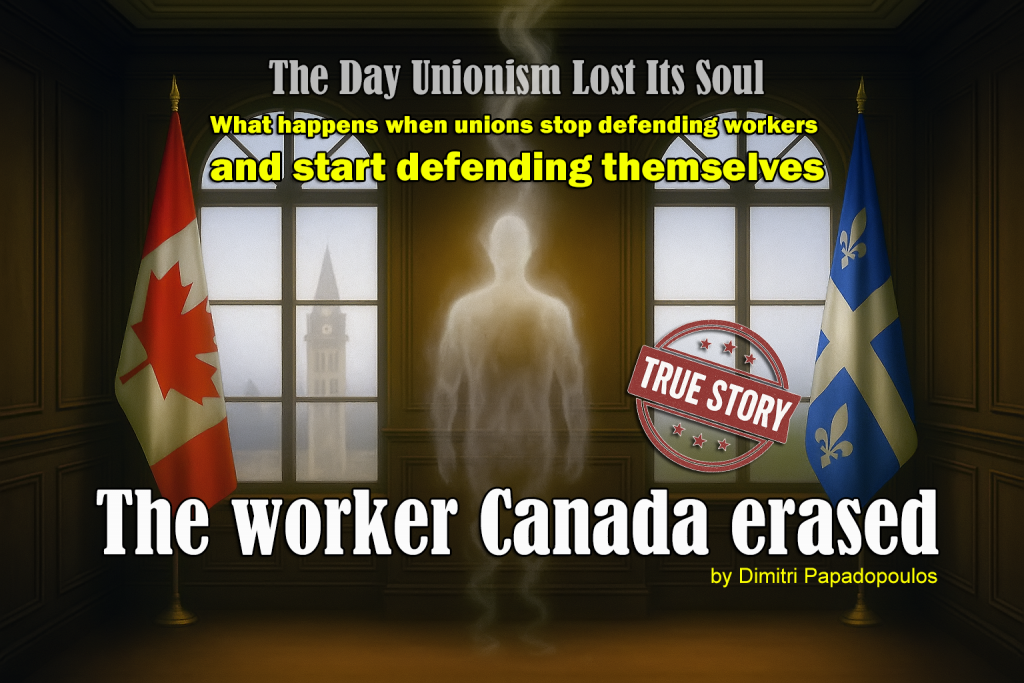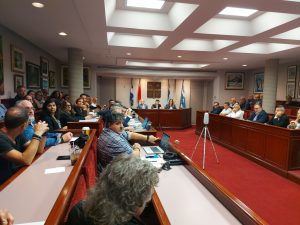
He trusted his union, believed in justice, and fought alone against an army of lawyers. The system erased him, and justice looked away.
This is the story of a worker who believed in union protection until the very system he funded turned against him. A simple case that became a symbol of everything unionism and administrative justice should never become.
The Heart of the Case
The heart of this case concerns a “union decision” that was never formally documented in the record. It originated as an administrative interpretation later repeated in higher decisions to support the Board’s reasoning.r
By Dimitri Papadopoulos
In 1997, I was hired as a radio operator in Montreal by a major unionized broadcaster, a job I loved with an absolute passion. For seven years, I worked tirelessly, often more than sixty hours a week, anchored by the confidence that I was protected. The collective agreement was my guarantee of job security and clear compensation in case of automation.
My commitment to this work was never just about a paycheck; it was about public service. During Montreal’s catastrophic 1998 Ice Storm, our radio station (and sister stations) was one of the few mainstream English broadcasters that remained on the air. I happily worked triple overtime for days on end that month, ensuring our programming was delivered from an infrastructure kept alive only by the hum and fumes of diesel generators.
People depended on us for critical information in a time of crisis. Being part of that crew was one of the proudest moments of my life. I remember literally crying when I saw my name, along with all the others, printed on a full-page “thank you” in the Montreal Gazette.
I loved my job. I was proud of my work. And I trusted the system meant to protect me. That profound sense of security and pride made the spiral that followed all the more incomprehensible.
The Beginning of a Spiral
In December 2004, everything collapsed. My position was eliminated with four days’ notice due to automation. According to our union’s collective agreement, I was entitled to a significant payout, specifically the severance pay calculated based on my years of service as a full-time employee. The unions shop steward, in her flawed opinion, insisted I was part-time, but even if that were true, the collective agreement still guaranteed a separation allowance based on hours worked.
The union made no effort to secure either.
This vacuum of representation left the employer free to opt for the quick-fix that worked best for him without second thought: exploiting the loophole of keeping me ‘active’ on the employee list. On paper, I was still employed. In reality, I was jobless, without salary, without employment insurance, and without security.
Two other employees met the same fate. This form of constructive dismissal, already tested by the employer, proved remarkably effective. The employer’s action, combined with the union’s inaction, created a method to bypass the collective agreement entirely.
The Administrative Trap
This fiction of being “still employed” trapped me in a legal limbo. I was no longer paid, yet not officially dismissed, which meant I could not qualify for unemployment benefits. Within days, my life collapsed: no income, creditors calling, and no recourse.
Before resorting to formal measures, I made numerous attempts to resolve the situation amicably, requesting only the severance pay stipulated in the collective agreement. These efforts, directed to the chief shop steward, were consistently rebuffed. My email correspondence was met with summary dismissals of my contractual claims, while phone calls were met with open hostility. As a final attempt at a non-confrontational solution, I requested a group meeting with the other affected employees, but the steward insisted on a private, one-on-one meeting. That meeting, held behind the closed door of a production studio, produced no resolution, instead escalating into a non-productive confrontation where the steward asserted her authority rather than addressing the substance of my claims.
With all informal avenues exhausted and any amicable resolution clearly impossible, the only recourse left was the proper, formal channel.
In a unionized environment, the proper channel is to file a grievance. That’s what I did. On February 11, 2005, I completed and send via registered mail an official grievance form for constructive dismissal. The union received it on February 15, 2005. And yet, that grievance was never processed. No acknowledgment, no meeting, no decision. Nothing. That document, now public, is known as Exhibit S-4.
The filing of the formal grievance was followed by complete silence on the part of the union.
A Silent Union
When I called my national union representative at the Union Headquarters to ask about my case, his response was blunt: “Stop bothering me”, before hanging up. The message was clear. The union wanted nothing to do with it.
I still believed, naively, that this was a misunderstanding. But the silence persisted. And later, that silence became the very “decision” the union claimed to have made.
After the grievance was filed, there was total silence. No response, no follow-up, no acknowledgment. The document sat unprocessed in the record, unsigned and untouched.
In Quebec’s labour relations system, the path to justice for workers depends entirely on whether they are unionized or not.
For non-unionized employees, complaints related to employment standards or unfair practices in Quebec can be filed directly with the Commission des normes, de l’équité, de la santé et de la sécurité du travail (CNESST), an unbiased government agency for work-related issues, and the matter is adjudicated promptly under applicable labour law and common sense.
For unionized employees, however, everything changes. Their access to justice is filtered through the union, which holds exclusive control over their representation. The worker’s voice, once unionized, becomes secondary to the will of the Union that claims to represent them.
A complex situation arises when a union fails its member by refusing to advance a legitimate grievance. In such cases, the worker cannot turn to the CNESST for help. Instead, they must take legal action against their own union before the Labour Administrative Tribunal, accusing it of breaching its “Duty of Fair Representation” with what is known as a “DFR Complaint”.
If that complaint is dismissed — as nearly all are — the worker is left without recourse. The original workplace injustice remains unaddressed, while the union walks away shielded by the very legal system meant to hold it accountable.
After filing my grievance, no further communication ever followed. With no direction and no idea how to proceed, I started asking around. That is when I learned that my only remaining option was to file a Duty of Fair Representation complaint against my own union with the Canada Industrial Relations Board.
So I did.
I had no idea at the time what kind of labyrinth I was stepping into. This was the point where the Union mobilized top-tier lawyers, invoked every procedural trick in the book, and fought not to defend justice but to defend itself.
One Worker Against an Army of Lawyers: David vs. Goliath
Without a lawyer or resources, I stood alone against a team of union lawyers funded by the dues of thousands of workers. On one side, an unemployed technician. On the other, a law firm of seasoned legal experts, including some of the top specialists in Canadian labour law. An uneven fight that symbolized, in itself, the imbalance between the individual citizen and the institutions supposedly designed to protect him.
What could have been settled around a table in a few hours instead became a national legal battle. A simple issue of union representation was not resolved by correcting an obvious error, but was instead escalated into a multi-year legal fight that became, in effect, a demonstration of institutional power.
Administrative Labour Tribunal
The Canada Industrial Relations Board, mandated to adjudicate disputes between workers and unions, dismissed my complaint after reviewing the submissions of both parties.
In theory, this federal administrative Labour Board protects workers. In practice, the Board’s membership is drawn from individuals with extensive backgrounds in labour relations, including prior experience as negotiators, counsel, or administrators within that field.
The outcome reflected an administrative structure that appeared to prioritize procedural consistency over individual redress.
The union informed the Canada Industrial Relations Board that, after reviewing the circumstances, it had decided not to file a grievance. The Board accepted that explanation as evidence of a decision, though no written resolution was entered into the record.
And yet that claim, never verified or proven, was accepted by the tribunals as sufficient reason to reject the case. What the union described as a “strategic choice” effectively amounted to a withdrawal of representation presented as procedural discretion.
To the Board, doing nothing at all was not misconduct. It even accepted a few informal emails, written before the grievance was officially filed, as “proof” that a decision had been made.
But those emails were not part of any process. They were emotional, personal exchanges, informal correspondence where I even mentioned my experience at the ATHENS 2004 Olympics. They had little to do with the grievance later filed.
The CIRB decided that these casual emails constituted a “union decision.” A conclusion both illogical and absurd, since the grievance form itself contained facts never mentioned in those earlier emails. In other words, the Board recognized as a “decision” an exchange about events that had not even occurred yet.
Meanwhile, the union’s lawyer relentlessly repeated that those emails represented a “decision not to proceed.” The Board and later the courts accepted that version without a single verification.
At the time, little I knew that complaints filed by workers against their unions for breaching the Duty of Fair Representation (DFR complaints) are automatically dismissed in roughly 99% of cases. Anecdotal observation suggests that successful Duty of Fair Representation cases are exceptional, often cited as examples of the system’s ability to self-correct rather than as indicators of a consistent trend.
My case didn’t fall through the cracks. It was neatly filed away, just like the countless others before it. The Board’s decision (CIRB LD 1533) was a familiar performance, complete with its trademark chorus:
After having analyzed the submitted facts and the positions of the parties in light of these principles, the Board finds that the complainant did not bring forward sufficient facts to establish that the union violated its obligations with respect to its duty of fair representation.
For the reasons cited above, the complaint is dismissed.
One might almost admire the consistency. The CIRB may not deliver fairness, but it certainly delivers repetition.
A Distortion of Process
The central issue in this case is the union’s after-the-fact invention of a “decision” and the failure of tribunals to verify the most basic facts of the timeline.
The union’s lawyer relentlessly repeated that the email exchange from February 11, 2005, represented the union’s “decision not to proceed” with the grievance. The Board and, later, the courts accepted that version without a single verification.
This narrative is factually impossible, based on the union’s own evidence.
The formal, written grievance (Exhibit S-4) was only received by the union on February 15, 2005. The shop steward’s email, the one the courts would later call the “decision”, was sent on February 11, 2005.
The shop steward’s pre-emptive brush-off was sent before the formal grievance had even been received.
The Illusion of Due Process
A true decision in a grievance process, as outlined in the collective agreement, requires a formal procedure. The process starts with a written submission (Step 2), which then requires:
- A formal acknowledgment by the union.
- A review of the case, including management’s position.
- A documented conclusion from the Union Grievance Committee on whether to proceed.
According to the collective agreement, the Union Grievance Committee is defined in Step 2 of the grievance procedure (Article 36).
It states that the committee “shall normally not exceed three (3) employees including a representative of the present bargaining unit“.
None of that existed. The February 11 email was an informal, pre-emptive brush-off, not a procedural “decision.”
Turning those informal chats into an “official decision” was not a misunderstanding; it was a distortion of justice itself. Encouraged by the union’s lawyers and endorsed by the Board, this fiction created the illusion of due process where only silence existed. For the Board, there was no longer any need for a real process. The CIRB simply believed the union’s narrative, ignoring the fact that the grievance form wasn’t even received until February 15.
Before the Federal Court of Appeal
Confronted with this bureaucratic fantasy, I turned to the judicial system, believing it would be more rigorous, more attentive to facts, and less vulnerable to fabricated narratives. I filed for judicial review before the Federal Court of Appeal, convinced that the truth would finally prevail.
It wasn’t a crusade, just a simple request: that someone, somewhere, recognize the obvious, that a grievance left unanswered is not a “decided” grievance.
But on December 11, 2008, the Federal Court of Appeal issued its ruling (2008 FCA 415). It fully upheld the Board’s decision, declaring its actions “reasonable in the circumstances” and finding that “no rule of natural justice had been breached”.
At Federal Court, everything shifted. The core facts of the case—a constructive dismissal and an abandoned worker—veered away from the spotlight and toward a safer abstraction: natural justice. This pivot from facts to principles had the effect of turning an act of neglect into a matter of procedure. The result was a hollow case, stripped of meaning and emptied of responsibility. The Court, believing it was upholding the law, ultimately ratified a convenient fiction.
A victory for form, a defeat for justice.
The Court’s reasoning became circular: since the process had been imagined, it was therefore reasonable. The very notion of reasonableness in Canadian administrative law, which was the new standard the Court applied in this case, had immediately become a shield against judgment itself. The judges endorsed the Board, invoking a new test so deferential that it made reversal virtually impossible. In their reasoning, they relied on older precedents to justify this high level of deference, making it clear that the bar for reversal was almost impossibly high.
The only existing grievance, received on February 15, 2005, was the one the union had submitted as evidence, the Exhibit S-4. It shows, beyond any doubt, that no action or decision ever followed. Despite this, the Court accepted the rewritten story, granting legal legitimacy to what was nothing more than silence.
The Court wrote, in essence, that I had failed to show that natural justice was violated, and that the Board’s reasoning fell within the range of acceptable outcomes.
How could abandonment be an “acceptable outcome”? How could ignoring a grievance be considered representation? How could any judge, looking at a signed grievance without a single union signature or step, conclude that justice had been served?
The answer, in my opinion, lies in institutional culture, not law. The Federal Court of Appeal’s decision to defer so completely leaves the impression that it was a choice driven by a desire to avoid questioning an entire ecosystem, what appears to be a comfortable alliance between unions, bureaucrats, and the courts that police them. Instead of restoring balance, the Federal Court fortified the imbalance.
The Final Hope: The Supreme Court of Canada
My last resort was the Supreme Court of Canada, the final hope that a higher court would recognize the injustice.
The case was filed under number 33044. The Court summarized it in one sentence: “The union did not pursue the grievance.”
Everything is said in that line. But instead of treating it as a serious fault, the Supreme Court refused to hear the case, no explanation, no hearing, no correction.
That sentence, printed in the Court’s official summary, reads like an indictment: “the union did not pursue the grievance.” And yet no one, not even the country’s highest court, found it troubling.
The Paradox of Modern Unionism
Unions claim to be the voice of workers. But when they turn against one of their own, that voice becomes an instrument of control.
What was meant to be protection becomes hierarchy. What was meant to be solidarity becomes institutional self-defense.
In my case, the union chose to protect its image instead of its member. And in doing so, it found comfort in the very system meant to hold it accountable.
This isn’t unionism; it’s a caricature. A bureaucratic structure more interested in preservation than in principle.
The Pyrrhic Victory of Institutional Defence
From a purely bureaucratic perspective, the union’s decision to fight was a tactical success.
But at what cost?
It avoided a legal finding of breaching its Duty of Fair Representation, a precedent all unions fear. But this short-term legal win was secured at an immense and lasting strategic cost.
This was not a battle fought in a vacuum. The union’s victory was not a defence of principle but an abdication of it. By fighting to suppress the grievance, the union was not saving itself from a claim without merit; it was actively shielding the employer from its contractual obligation to pay a severance that its own member was entitled to.
In essence, the union spent its members dues on a legal fight that had the practical effect of doing the employer’s bidding and providing them a direct financial favour..
This action inflicted profound collateral damage. By dragging this clear-cut case into a multi-year legal saga, the union created a perfect, documented case study of its institutional priorities being inverted. It then implicated the judiciary in this betrayal, forcing the courts to apply a deferential reasonableness standard to a factually impossible narrative.
The resulting judgments damage public confidence not just in the union movement as a practical body, but in its core ideology, and in the courts’ capacity to deliver substantive justice.
The union “won” its case by relying on procedural arguments and legal technicalities, but it left a public record that undermines the perceived integrity of both Canadian unionism and the justice system itself.
The official summary from the Supreme Court of Canada is not a complex legal argument. It is a single, devastating sentence of plain fact:
“The union did not pursue the grievance”.
That one line, set in stone forever in the public record, tells the general public everything.
To an ordinary person, this fact cuts through all the legal jargon about “Patent unreasonableness” and “Mutatis mutandis“. It is an epitaph for the case, and it communicates a simple, powerful narrative of abandonment. It signals that the very organization a worker pays for protection, at their moment of greatest need, simply failed to do its most fundamental job.
It confirms the worst public stereotypes about unionism: that it can be a self-serving bureaucracy that collects dues but, when it matters most, will abandon the very worker it was created to defend. It is a permanent, public record of institutional failure, stated in the plainest language possible by the highest court in the land.
There is an old saying: Pick your battles. This was not just a poor choice for the union to fight; it was a profound strategic blunder that strikes at the very ideology of unionism itself.
The legal and procedural defenses available to a union—the high bar for a DFR complaint, the deference granted by courts—are potent tools. They exist, arguably, as safeguards for the collective good, perhaps even to quietly resolve an internal matter that might be embarrassing for a complainant to see go public.
But this case documents a complete inversion of that purpose.
The union deployed this entire defensive playbook, and made it public, not to protect its worker, but to do the employers bidding, shielding the company from a valid, contractual severance payout. They used the tricks of the trade against their own member.
The Danger of the Precedent
The most significant outcome lies in the precedent that followed. Following review by the Federal Court of Appeal and the Supreme Court of Canada, the reasoning was upheld, confirming that a union’s refusal to act can be treated as a decision if it is clearly communicated to the member.
And now, because the system defended procedure over justice, it can and will happen again — legally.
The most alarming part is that this precedent is not theoretical. Its replication has already begun.
The Canada Industrial Relations Board, in a subsequent decision (2009 CIRB 439, paragraph 18), has already used my case as legal authority. It quoted the Federal Court of Appeals ruling from my case to justify dismissing another members application for reconsideration.
In effect, my case evolved from a dispute over representation into a precedent now cited in similar matters involving union discretion, successfully using it to beat another workers complaint by validating the same logic.
When law becomes this detached from justice, it’s not just a failure; it’s a surrender.
What this case says about Canada
This is more than one man’s case. It is a mirror held up to the Canadian justice system — and to the state of unionism itself.
A worker was constructively dismissed, stripped of income, and left without recourse because his “employment” continued on paper. His union abandoned him. The labour board rewrote reality to protect the union. The courts validated that rewrite. The Supreme Court looked away.
That is the true legacy of this case. Not the name, not the file number, but the message it sends: that in Canada, an unrepresented worker can be erased from justice, and every institution will call it fair.
The Court as the Fulcrum of Justice
The judiciary functions as the essential guarantor of a balanced, orderly, and predictable society. The public’s confidence in the rule of law rests on the fundamental expectation that courts will act as impartial arbiters of fact and deliver substantive justice. When judicial bodies appear to endorse procedural fictions over clear evidence, this core covenant is broken. Such outcomes risk fostering public cynicism and eroding faith in the very institutions sworn to protect social order. This is not a mere abstraction; it is the bedrock of the social contract, and its erosion projects an image of arbitrary power, not justice, which is antithetical to the principles of the Canadian legal system.
The Final Questions
When all is said and done, this case poses fundamental questions that every union leader, labour lawyer, and member of the judiciary should be forced to answer.
First, to the labour movement: Is this the intended purpose of unionism? A bureaucratic reflex for institutional preservation that left the individual without remedy? Is “solidarity” a mere slogan, abandoned the moment a worker stands alone against the apparatus?
Second, to the judiciary: Is this the intended function of Canadian justice? An adherence to procedure that overshadowed substantive examination? A system of deference where the standard of “reasonableness” provides a legal shield for the factually absurd?
If the answer to these questions is yes, then these institutions have become untethered from their founding principles – one of solidarity, the other of truth.
If the answer is no, then it is time for those of integrity within both systems – the principled, the honest, and the brave – to reclaim them from this spiral of complicity. Justice cannot coexist with institutional self-interest, and public faith cannot survive where there is no accountability.
Annex: Analysis of Discrepancies in Union’s excuses
As established throughout this article, the tribunals and courts repeatedly pointed to an email from the shop steward, dated February 11, 2005, treating it as the formal decision of the Union.
A review of that email shows several inconsistencies when compared with the wording of the collective agreement that was in force at the time.
The explanations provided in that message contained inaccuracies and omissions concerning the rights afforded to part-time members under the collective agreement.
Key discrepancies include:
- Layoff Protections (Article 21.2): The steward stated that the layoff protections in Article 21.2 did not apply to part-time employees. The collective agreement, however, included that article among the provisions applicable to part-time staff. Letter of Intent 12, which governed part-time employees, explicitly listed Article 21.2 in the Clauses applicable column. This article governed the inverse order of unit seniority in a layoff scenario and was a key protection that was applicable but ignored. This article governed the inverse order of unit seniority in a layoff scenario a key protection that applied to my position but was not relied upon in the union’s interpretation.
- Separation Allowance (Article 21.15): The steward’s email was incomplete in its reference to the applicable articles. It stated that Article 21.17 (severance pay for permanent full-time employees) did not apply. However, It did not mention Article 21.15, which provided a separation allowance for part-time employees whose employment ended.
This analysis indicates that the steward’s decision not to support a grievance stemmed, at least in part, from an inaccurate interpretation of the collective agreement. Important protections and timelines that applied under the collective agreement were not reflected in the steward’s personal email, which was later treated by the tribunals and courts as the union’s formal decision.
The available record suggests that the grievance met the criteria for pursuit under the collective agreement.
All documents in this case are public:
- the unprocessed Grivance (Exhibit S-4),
- the CIRB decision (CIRB LD 1533),
- the Federal Court of Appeal judgment (2008 FCA 415),
- and the Supreme Court of Canada summary (Docket 33044, tab “Summary”).
The documents show how one worker’s dismissal remained unresolved through successive findings that deemed the process “reasonable.”
For The Public Record
In the end, the institutions involved have spoken through their decisions. What remains is the public record preserved in these pages. Every decision and omission is preserved for future readers, researchers, and lawmakers who may one day study this case as an example of how institutional processes can fall short of the people they are intended to protect. The purpose of this publication is to preserve the evidence so that its lessons may, in time, contribute to strengthening the integrity of the justice process.
Welcome to Canada, our home and native land, where justice sometimes fails those it was designed to protect.










